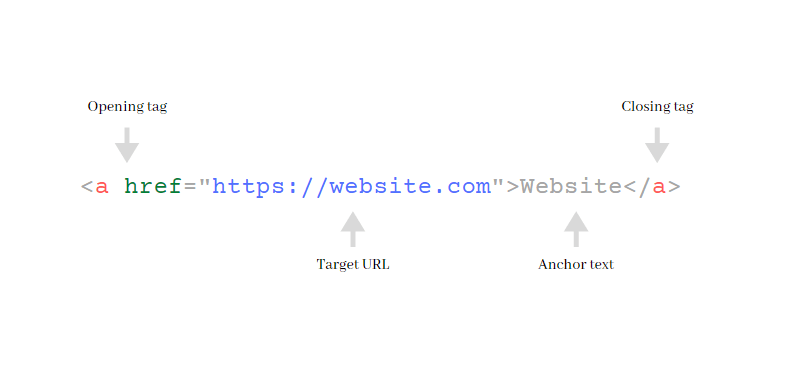The HTML <a> tag, also known as the anchor tag, is one of the most fundamental elements in web development. It’s used to create hyperlinks that connect one web page to another, link to downloadable files, or navigate to sections within the same page.
Here’s a basic example of an anchor tag in HTML:
<a href="https://www.example.com">Visit Example</a>This simple line of code creates a clickable text link — “Visit Example” — that takes the user to https://www.example.com.
HTML <a> Tag Syntax
The <a> tag works as both an opening and closing tag. The syntax is:
<a href="URL">Link Text</a><a>— the anchor tag itself.href— the “hyperlink reference” attribute that defines the destination URL.Link Text— the clickable part users see on the webpage.
Example:
<a href="about.html">About Us</a>This link will take users to the “About Us” page of your website.
Common Attributes Used with the HTML <a> Tag
To make links more useful, HTML provides several attributes that modify how links behave.
1. href Attribute – The Hyperlink Reference
The href attribute defines the URL of the page or resource you want to link to.
Examples:
<a href="https://www.webfulcreations.com">Visit Webful Creations</a>
<a href="mailto:[email protected]">Email Us</a>
<a href="tel:+1234567890">Call Now</a>You can also use relative paths to link pages within the same website:
<a href="/contact/">Contact Us</a>2. target Attribute – Control Where the Link Opens
The target attribute specifies where the linked document opens.
Common values:
_blank— opens the link in a new tab or window._self— opens the link in the same tab (default)._parent— opens in the parent frame._top— opens in the full body of the window.
Example:
<a href="https://www.example.com" target="_blank">Open in New Tab</a>3. rel Attribute – Relationship Between Documents
The rel attribute defines the relationship between the linked document and the current page.
Common values include:
nofollow— tells search engines not to follow the link.noopener— prevents security risks when using_blank.noreferrer— hides referrer information.sponsored— marks paid or affiliate links.
Example:
<a href="https://affiliate-site.com" rel="nofollow sponsored" target="_blank">Buy Product</a>4. title Attribute – Tooltip Text
The title attribute shows a small tooltip when users hover over the link.
<a href="/services" title="Learn more about our services">Our Services</a>This can help improve user experience and accessibility.
5. download Attribute – Downloadable Files
The download attribute allows users to download a file instead of navigating to it.
<a href="/files/guide.pdf" download="WebDesignGuide.pdf">Download Our Guide</a>Types of Links You Can Create Using <a> Tag
1. Internal Links
Used to link pages within your own website.
Example:
<a href="/blog/">Visit Our Blog</a>2. External Links
Used to link to another website.
Example:
<a href="https://www.google.com" target="_blank" rel="noopener">Go to Google</a>3. Anchor Links (Jump Links)
Used to link to a specific section on the same page using an id attribute.
<a href="#contact">Go to Contact Section</a>
<!-- Later in the page -->
<h2 id="contact">Contact Us</h2>4. Email and Phone Links
<a href="mailto:[email protected]">Email Support</a>
<a href="tel:+1800123456">Call Us</a>SEO Benefits of Using the <a> Tag Correctly
Anchor tags are vital for search engine optimization (SEO).
Here’s why:
1. Improves Crawlability
Search engines like Google use anchor tags to discover and index new pages. Proper linking ensures your pages are easy to crawl.
2. Boosts Link Equity (PageRank)
Internal and external links help distribute ranking power across your website.
3. Enhances User Experience
Relevant anchor text helps users understand what kind of content to expect when they click a link.
4. Strengthens Keyword Relevance
Using keyword-rich anchor text in internal links helps search engines understand your page topics better.
Example:
<a href="/wordpress-maintenance-services/">WordPress Maintenance Services</a>This link uses a keyword-rich phrase that supports both SEO and clarity.
Best Practices for Using the HTML <a> Tag
- Use descriptive anchor text. Avoid generic terms like “click here” or “read more.”
- Always add
rel="noopener noreferrer"when using_blank. - Ensure links are visible and styled properly.
- Use internal linking wisely to connect related pages.
- Avoid broken links – check them regularly.
- Do not over-optimize with excessive keyword linking.
Common Mistakes Developers Make with <a> Tags
- Missing the
hrefattribute, causing non-functional links. - Using JavaScript for navigation when a simple
<a>would suffice. - Overusing
target="_blank"unnecessarily. - Linking to low-quality or spammy sites without
nofollow. - Forgetting accessibility roles or descriptive link text.
Practical Example: Complete HTML <a> Tag Usage
<p>Learn more about our
<a href="https://www.webfulcreations.com/services/"
target="_blank"
rel="noopener noreferrer"
title="Explore our professional web development services">
WordPress Development Services
</a>
and how we can help your business grow online.</p>This example includes:
- Proper
hreflink target="_blank"for new tabrelattributes for SEO and securitytitlefor UX
Frequently Asked Questions (FAQs) About HTML <a> Tag
1. What is the difference between <a> and <link> tags?
<a> creates clickable hyperlinks in the body, while <link> defines relationships between documents in the <head> (e.g., CSS files).
2. Can I create a button with an <a> tag?
Yes! You can style an anchor tag to look like a button using CSS:
<a href="/signup" class="btn">Sign Up</a>
3. What happens if I omit the href attribute?
Without an href, the <a> tag won’t function as a link — it will just act as inline text.
4. Is it good to use too many <a> tags for SEO?
No. While links are important, too many outbound links can look spammy and harm your site’s credibility.
5. Should I use nofollow for all external links?
Not necessarily. Use nofollow for untrusted or paid links. For trusted, valuable sources, you can use normal (dofollow) links.
Conclusion – Mastering the HTML <a> Tag for Better SEO and UX
The HTML <a> tag is the foundation of web navigation and SEO. From linking internal pages to building external relationships, it connects the web together.
By using attributes like href, target, and rel properly — and crafting keyword-rich, descriptive anchor text — you can create a user-friendly, SEO-optimized website that both visitors and search engines will love.


